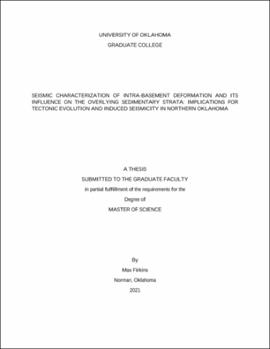| dc.description.abstract | Patterns of recent seismogenic fault reactivation in the granitic basement of north-central Oklahoma necessitates an understanding of the structural characteristics of the inherited basement-rooted faults. We analyze the top-Arbuckle, top-basement, and intra-basement structures in 9 post-stack time-migrated 3D seismic reflection datasets in north-central Oklahoma using structural seismic attributes. Across all surveys, sub-horizontal intra-basement reflectors (igneous sills) are observed, which commonly terminate at the basement-sediment interface. Overall, our results reveal 146 fault traces at the top of the Precambrian basement with dominant trends along WNW-ESE, NE-SW, and N-S. Many of these faults were previously unmapped, supporting the assertion that there is a considerable cumulative seismic risk from unidentified faults. First examined are a subset of eight 3D seismic surveys in which 115 of the basement faults were interpreted. Proximal to the Nemaha Fault Zone (NFZ), faults dominantly strike N-S, are fewer (<10), have the lowest areal density, lowest areal intensity, and exhibit the most significant maximum vertical separation. However, with distance from the NFZ, faults exhibit NE-SW trends, areal fault density increases, areal fault intensity increases, and maximum vertical separation decreases. Of these 115 faults, ~49% are contained within the basement, ~28% terminate in the Arbuckle Group, and ~23% transect units above the Arbuckle Group. These observations suggest that proximal to the NFZ, deformation is accommodated along a few but longer fault segments, and with distance away from the NFZ, deformation is distributed across more relatively shorter fault segments. The existence of through-going faults suggests the potential for spatially pervasive fluid movement along faults. In the Harper Creek 3D seismic volume, a sequence of 56 relocated earthquakes is collocated with the survey. These events delineate the actual structure of an intra-basement fault zone. This provides a means of guidance and validation on attribute-assisted basement fault interpretation. When included in the interpretation of basement faults, it shows two critical steps beyond curvature interpretation at the top basement. The first is to couple to curvature interpretation with an aberrancy attribute visualization. When included, aberrancy improves the quantity and placement of interpreted fault traces. Second, it is essential to analyze the units directly above the basement. In the sedimentary units, the faults tend to express more clear signs of too subtle structures to identify at the top of the basement. Results have direct implications for wastewater injection and seismicity in north-central Oklahoma and southern Kansas. Additionally, they provide insight into the characteristics of basement-rooted structures around the NFZ region and suggest how to characterize basement structures where seismic data are available. | en_US |
